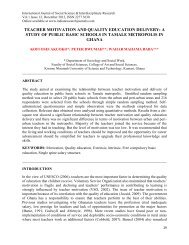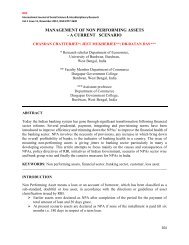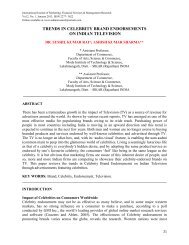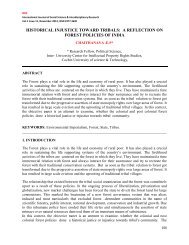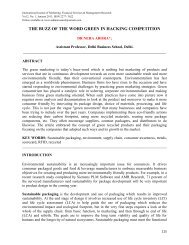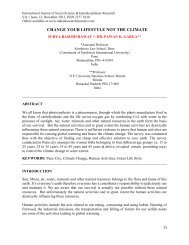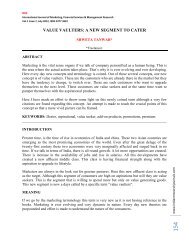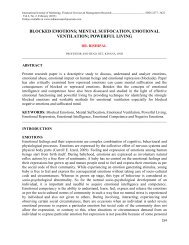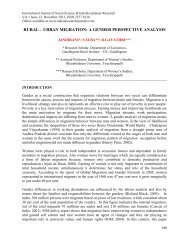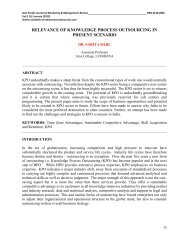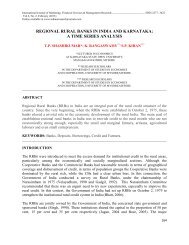PEACE EDUCATION AND HUMAN RIGHTS IN TWENTY FIRST ...
PEACE EDUCATION AND HUMAN RIGHTS IN TWENTY FIRST ...
PEACE EDUCATION AND HUMAN RIGHTS IN TWENTY FIRST ...
You also want an ePaper? Increase the reach of your titles
YUMPU automatically turns print PDFs into web optimized ePapers that Google loves.
International Journal of Social Science & Interdisciplinary Research<br />
Vol.1 Issue 12, December 2012, ISSN 2277 3630<br />
Online available at www.indianresearchjournals.com<br />
Futures Education developed in the USA and Canada in the 1970s‟ as teachers developed<br />
valuable classroom applications of the insights and tools developed in future studies‟ Although<br />
Future Studies has served many interests – including those of government, business and the<br />
military – Futures Education in schools has been largely a critical pedagogical enterprise, framed<br />
by the transformative values of social justice, peace and sustainability. The title of Hazel<br />
Henderson‟s seminal book Creating Alternatives Futures captured transformative intent.<br />
5 Conclusion and Suggestions:<br />
Learning to make a living is not the sole reason for getting education; there is another, equally<br />
important byproduct; learning to make a life, a life that is beneficial, useful and peaceful. After<br />
all, humans are social animals; their success in life is largely a matter of successful social<br />
relations. Quite evidently, student age is the crucially important period which enriches one‟s<br />
personal life, nurtures social adjustments, fosters friendship and understanding and affects one‟s<br />
whole life pattern. Seen from this perspective, one could very well understand the critical<br />
necessity of teaching students, youth and young leaders the art of living together, in mutual<br />
respect, justice, love and peace. The widespread interest in preparing individuals for peace on<br />
earth makes us resort to the teaching- learning process.<br />
This paper encourages teachers to be thinking broadly when planning to teach for peace. Human<br />
rights are the foundation of freedom, justice and peace. This respect allows the individual and the<br />
community to fully develop.<br />
References:<br />
1. Butterworth, Dawn and Fulnmer, Alison (1990), Conflict, control, power: a curriculum to teach<br />
peaceful conflict resolution to children aged 0-10, Child and Family Consultants, Dalkeith.<br />
2. UNESCO: (1994) UNESCO‟s culture of peace programme (Leaflet,<br />
3. Healy, Kaye ed. (1995), Conflict resolution, Spinney Press, BAL main.<br />
4. Janke, Rebecca and Pen shorn, Julie,(1995), Pacemaker‟s A,B,Cs for young children: a guide for<br />
teaching conflict resolution with a peace table, Growing Communities for Peace, Marine on St.<br />
Croix, Minn.<br />
5. Mayer, Richard (1995), Conflict Management: the courage to confront, Battelle Press, Columbus.<br />
6. Jenkins, Jean (1996), Resolving Violence: an anti – violence curriculum for secondary students,<br />
ACER, Camber well.<br />
7. Pearlstein, Ruth and Thrall, Gloria (1996), Ready-to-use conflict resolution activities for<br />
secondary students, Center for Applied Research in Education, West Nyack, and N.Y.<br />
8. Bellanca,James,(1997) Active Learning handbook for the multiple intelligence classroom,<br />
Hawker-Brownlow Education, Cheltenham.<br />
9. Reardon, Betty. (1997) „Human Rights as Education for the Twenty- First Century. (255-261).<br />
Philadelphia: University of Pennsylvania Press.<br />
10. Newsletter of Hague Appeal for Peace, vol2 (2) Sept.1999.<br />
11. Forcey, Linda and Harris, Ian eds (1999), Peace building for adolescents: strategies for educators<br />
and community leaders, P. Lang, New York.<br />
12. UNESCO International year for culture of peace (leaflet, 2000).<br />
13. Harris, Ian and Synott, John „Peace education for a new century‟, Social Alternatives, Vol21,<br />
No1, January, pp.3-6.<br />
203



